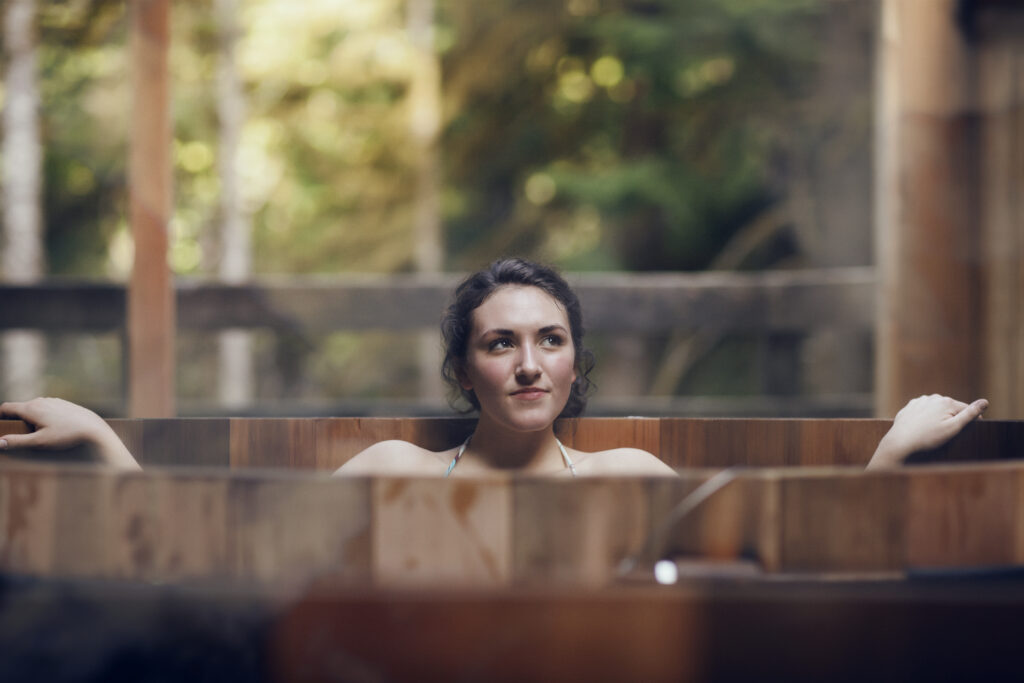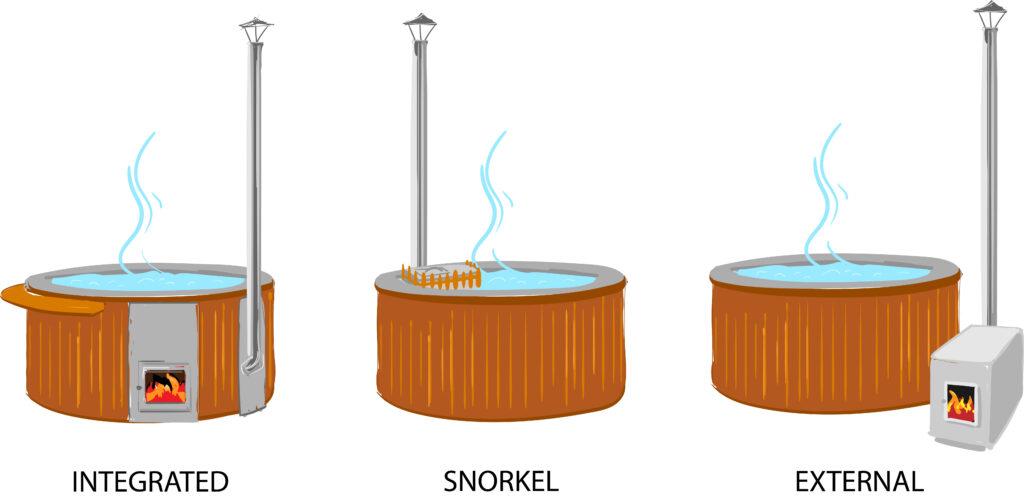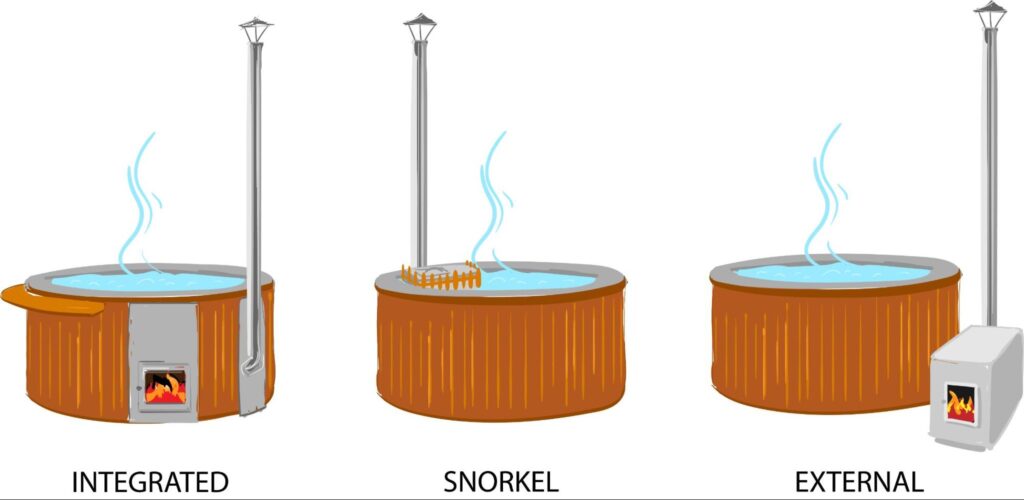
Wood-fired hot tub enthusiasts have been both blessed and cursed with the increasingly wide selection of technology solutions on offer when it comes to choosing the right hot tub unit for your home space. In this article, we provide you with a comprehensive guide to the various options available to help you narrow down exactly what type of hot tub will best meet your needs. We’ve compared the technology solutions present in Skargards, Gardenvity, Royal Tubs, Kirami and Timberin. When deciding on your ideal hot tub, make sure to consider your expected usage and whether you require more durable materials to withstand the elements and numerous users, or if you need something less heavy-duty and more cost-effective. So, let’s dive right in.
Practicalities of the various choices of technology and materials
Types of heaters
Integrated
- Do not require any additional space in the garden
- Fantastic look
- Take up some of the internal space of the hot tub
Internal (snorkel/submerged)
- Do not require any additional space in the garden
- Take quite a lot of space from the inside of the hot tub
- More challenging to clean
External
- Leaves all the tub space for more bathers
- A larger, more powerful heater can be used to heat the water more quickly
- Take space in the garden
- Requires extra caution when it gets hot
- Extra work removing leaves/dust/debris from the heater
Electric
- Offers a “set and forget” option
- Keeps the water in the tub at the desired temperature with no hands-on effort
- Takes much longer to heat the water
- Guaranteed to increase your electricity bills

Different massage systems
Air jets
- Offer a gentle full-body massaging
- Bubbles create an enticing look when combined with LED lighting
Hydro jets
- Create a stronger, more focused massage
- Require additional maintenance to prevent biofilm formation in the system
Combined
- Allows you to combine the benefits of both systems
- Tends to be more expensive
None
If you decide not to have a massage system, water filter and electric heating, the hot tub can typically be used in complete silence, which makes it ideal for peaceful, off-the-grid locations.
Water filtration options
Cartridge filter
- Easy to operate
- Simple maintenance
- Generally less expensive initial cost
- Filter cartridges need to be checked and replaced quite often, leading to higher operational costs in the long term
Sand filter (can be used with filter balls)
- The filtration lasts for several years without needing to replace the sand or filter balls
- Environmentally-friendly
- Generally higher initial cost
UV-C, Ozone or other treatment
- Helps to reduce the amount of sanitisers required to treat the water
- Sterilises and kills pathogens
None
- If you are not using a water filter, massage system or electric heating, the hot tub can usually be used in complete silence, which makes it ideal for peaceful, off-the-grid locations
- The water has to be replaced after each use
Practical and attractive design features
LED lighting
- A design feature that you can utilise in your hot tub for practical benefits as well as to set a fun or romantic mood. Typically, one LED with changing colour modes is offered, but some brands may allow you to add multiple points of light
Liner colour
- Creamy, white and beige colours are standard, but other variations include dark grey and navy, as well as red, green and gold tones, which are generally very rare
Drink holders
- Many brands offer a bar on the hot tub exterior side, as well as a liner with a special shape to provide space to hold glasses
Cover/lid
- A hot tub cover will protect the water from leaves, insects or other debris from falling in the water, but its other primary function is to reduce water heating time and keep it warmer for longer
- Wooden or plastic lids are heavier with inferior insulating properties
Types of materials
Type of alloy of the stove
- AISI 316 stainless steel, durable and resistant to different chemical elements, but it has a lower heat resistance than AISI304
- AISI 304 stainless steel offers better heat resistance than AISI316 but lower chemical resistance, so it is not recommended to be used with chlorine or saltwater
- AISI 430 grade stainless steel is the cheapest, but it cannot be used with chemicals in the water
- Aluminium does not corrode in clean water but will get damaged when exposed to chemical compounds like bromine, chlorine, lime and cement solutions or even chemicals present in tap water, such as fluorine, potassium and sodium
- Not specified – you will have to ask the company if you can use the stove with chlorine, for example
Liner material
- Acrylic – Most durable
Scratch resistant
Easy to maintain
Smoothest shape
Material coloured throughout - Fibreglass – Durable and repairable
Easy to maintain
Painted surface - LDPE plastic – Cheaper than acrylic or fibreglass
- Less elegant and durable than fibreglass or acrylic
- Due to limitations of the technology, it is not possible to have rounded corners, which causes sharper edges on seats
- No liner – Provides the natural feel of wood.
- Shaper edges on the seats
- No reclining positions
- Requires more maintenance
Type of wood
Thermo-processed wood (Thermowood)
- The most durable and stable
- Resistant to rot
- Low maintenance
- Looks stylish
- Lightweight
- Expensive
Spruce or larch
- Most economical
- Has to be treated regularly and is not highly durable
Cedar
- Best for insulation
- Rough texture
- Expensive
Oak
- Exceedingly strong and durable
- Naturally resistant to mould or fungi
- Looks beautiful
- Expensive
- Heavy
- Tends to shrink and expand
Untreated wood (very rare)
- Susceptible to quick deterioration
Features and technology solutions used by top brands

1. Skargards
Liner: White fibreglass
External finish: Thermowood
Heater: Snorkel (internal); integrated – standard or DualBurn; steel AISI 316; secondary electric heater available (frost protector)
Water filter: Sand filter with polymer filter balls
Massage system: Air
LED lighting: Yes
Cover: Bi-fold insulated lightweight cover
Other accessories: Minibar, one type of wooden steps, hearth plate, chimney extension and a cap, flue guard
2. Gardenvity
Liner: Fibreglass and acrylic; white, gold, blue, grey; all-wood
External finish: Thermowood
Heater: Integrated and external; steel AISI 304 as a standard, can be upgraded to AISI 316; secondary electric heater available
Water filter: Cartridge or sand filter with fibre balls, UV-C module available
Massage system: Air and/or hydro
LED lighting: Yes; 1 big or 10 small LEDs
Cover: Bi-fold insulated lightweight cover
Other accessories: Minibar, metal drink holder, two types of wooden steps, hearth plate, towel rack, handrail, liner insulation, wooden box for water filter
It is important to clarify that parts like chimney extension, heat protection and stirring paddle are added to the standard hot tub package, so they don’t have to be bought as accessories from Gardenvity.
3. Royal Tubs
Liner: Fibreglass and acrylic; white, blue, grey; all-wood
External finish: Spruce, larch, thermowood, oak, red cedar
Heater: Internal, integrated and external; AISI 304 and AISI 316; secondary electric heater available
Water filter: Submersible cartridge or external sand filter with fibre balls, UV light available
Massage system: Air and/or hydro
LED lighting: Yes
Cover: Wooden and bi-fold insulated lightweight cover
Other accessories: Minibar/drink holder, chimney extension, two types of wooden stairs, heat protection, stirring paddle, top rim decoration, liner insulation
4. The Log Company (Kirami)
Liner: Grey, blue, beige or champagne plastic, or all-wood
External finish: Spruce, red cedar, thermowood, recycled plastic, copper (metal)
Heater: Internal and external of different sizes and power (18, 22, 28, 29, 35, 42 kW); a diesel and electric heaters are also available
Water filter: Sand filter with filter fibre and cartridge filter
Massage system: Hydro
LED lighting: Yes
Cover: Plastic, wooden and bi-fold insulated lightweight cover
Other accessories: Thermometer, mini bar/drink holder, chimney extension, five types of wooden stairs, heat protection, heater glass door, stirring paddle, water treatment products, ash shovel, skimmer net, neck rest, hearth plate, liner insulation
5. Timberin
Liner: Fibreglass, polypropylene; white, blue, grey, black as a standard or any custom colour; all-wood
External finish: Spruce, larch, thermowood, oak
Heater: External, integrated, or internal wood stove, steel AISI 430 and AISI 316, electric heater available
Water filter: Sand filter with filter balls, UV lamp
Massage system: Air and/or hydro
LED lighting: Yes, from one to four
Cover: Fibreglass, wooden
Other accessories: Thermometer, mini bar/drink holder, luxury wooden edge, water cleaning set, four types of wooden stairs, heat protection, wooden box for the water filter, liner insulation
Time to decide
After reading the above guide, you now have more of the knowledge you need to move forward with your decision about what type of hot tub is right for your home. Use this information to keep researching the options that meet your needs, in the hope of boiling down the ideal hot tub for your unique situation and preferences.
We have also put together a helpful checklist for comparing different brands and options when choosing a wood-fired hot tub. If you haven’t already subscribed to our email communication to receive the checklist in your inbox, sign up now and download a free printable copy [link for a signup pop-up] to keep for further reference.




